Executive Summary
Bottega Veneta is a globally renowned brand, yet its performance could use a bit of a boost due to the need for expansion that the company has been experiencing recently. Product diversification and the creation of a new line of goods can be mentioned as available solutions for Bottega. The company needs to reinvent its brand by placing the emphasis on the importance of quality in everyday items and reducing the extent of luxury that is typically attached to its products. Shaping the brand image in the way that will connect it to the main brand of the organization, Bottega will be able to launch a new production line.
Introduction
Transitioning from being a brand that produces luxury items to the one that offers products for everyday use seems nearly impossible. However, Bottega Veneta may be able to accept the challenge successfully if all elements of the brand management process align. By marketing its new items for everyday use as the ones that allow for comfort and help to introduce a bit of luxury into the everyday routine of customers, Bottega will be able to create an entirely new and stunningly successful brand.
Pen Portrait and Competitor Analysis
Digital Pen Portrait
It is believed that the population, which Bottega currently targets, can be described as striving to introduce luxury and comfort into their home. Using the latest media tools to simplify their routine, Bottega’s buyers prefer comfort to innovation, while not opposing the latter. In addition, due to the inclination to use digital tools, the target audience is likely to live in the fast lane.
Digital Competitor Analysis (POPs and PODs)
PODs will include the comfort of users since Prada, Fendi, and Loewe promote luxury similarly to Bottega, but they do not concern themselves with everyday items and their usability (Sowray 2019). High quality and effectiveness are the main POPs, which Bottega will have to research carefully to ensure that the set standards meet the ones by which other organisations are represented in the market.
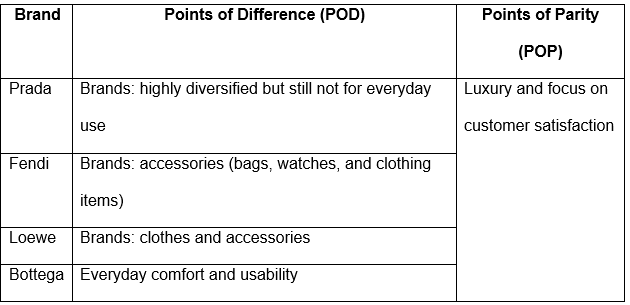
Brand Inventory
Heritage and History
Bottega Veneta has been known as the luxury products and designer clothes brand since 1966 (Our history 2019). Located in Italy, the company has gained impressive influence in the luxury design market. By focusing on developing the brand that will be utilised to represent a new and memorable brand identity, one will be able to capture the luxury everyday products market effectively.
Brand DNA
The brand DNA will allow positioning the organisation as innovative and focusing on quality and users’ comfort. Therefore, the DNA will be based on the vision of promoting comfortable life. The mission of the brand will be to simplify the daily routine and make it more exciting and satisfying. The values such as integrity, focus on customers, responsibility, and high quality will become the foundation for the development of the brand DNA (see Fig. 2). Based on the Onion Model, the suggested approach will help to track down the shift from the current brand to the one that is about to emerge.
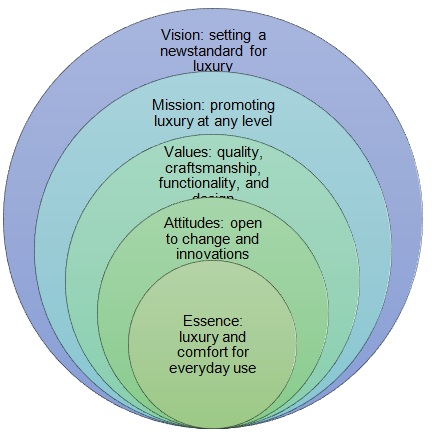
Brand Personality
To describe the personality of the brand to be produced, one will need the Aaker Model. Using the five personality factors outlined by Aaker, one will realise that the brand to be developed can be described as sincere, highly competent, and moderately sophisticated (Toldos-Romero & Orozco-Gómez 2015). Addiionally, the presence of luxury elements may increase the excitement slightly. The ruggedness of the products will be reduced to minimum to retain their sophisticated nature (see Fig. 3).
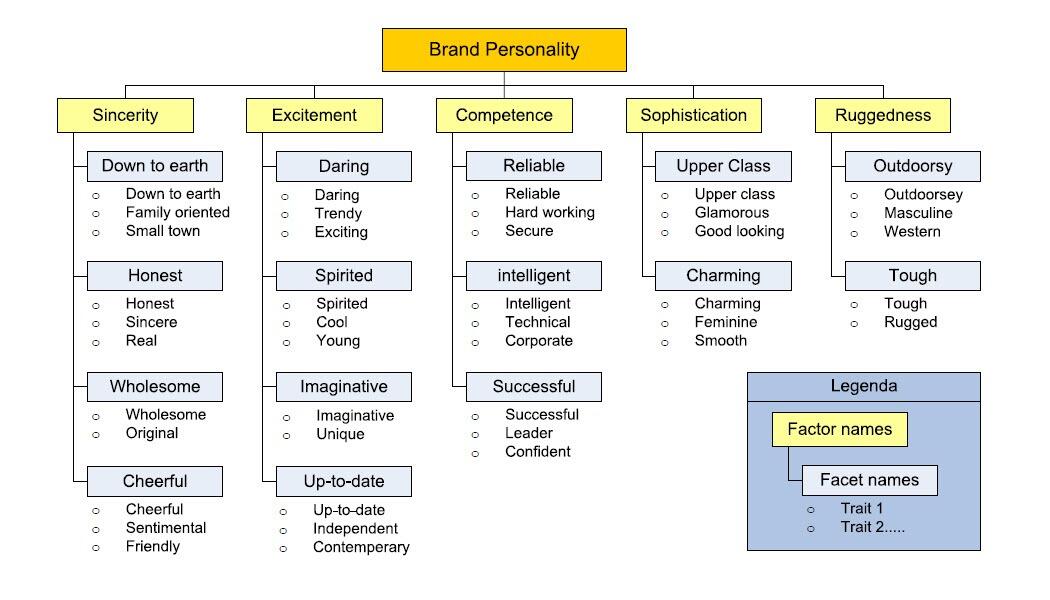
Bottega Veneta Brand Identity
The identity of the brand will be constructed using Kapferer’s approach. As Figure 4 shows, it is important to make an intercultural connection between the sender and the recipient (Rashid & Ghose 2015). In case of Bottega, the rapport between the buyer and the organisation will be developed via a feedback system. The data obtained from surveys and questionnaires will be used to incorporate culture-specific elements into the brand products and tailor them to customer-specific needs.
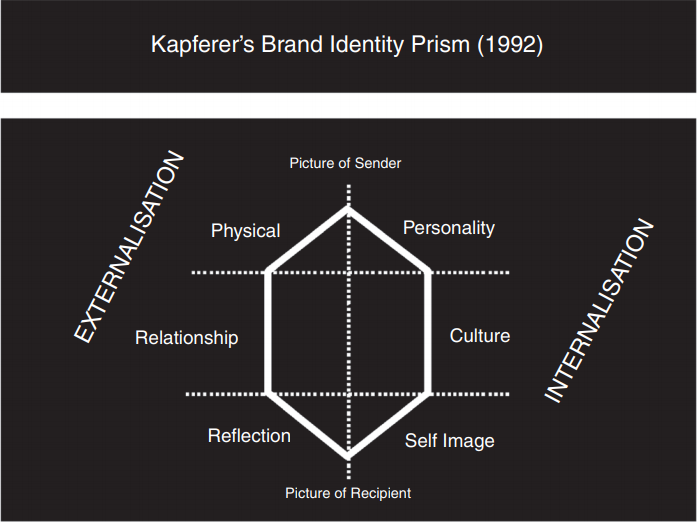
Brand Equity
To increase the brand equity of Bottega, particularly, its new line of products, one will need to consider Keller’s Brand Equity Model (see Fig. 5). The model suggests that the brand identity needs to be constructed based on how customers and the company interact, starting from the core values of the organisation and to the perspective that it introduces into the company-customer communication (Çifci et al. 2016). Therefore, the brand equity of Bottega’s new line of products should be structured as the use of high quality and innovative design to introduce moments of luxury into their customers’ everyday lives.
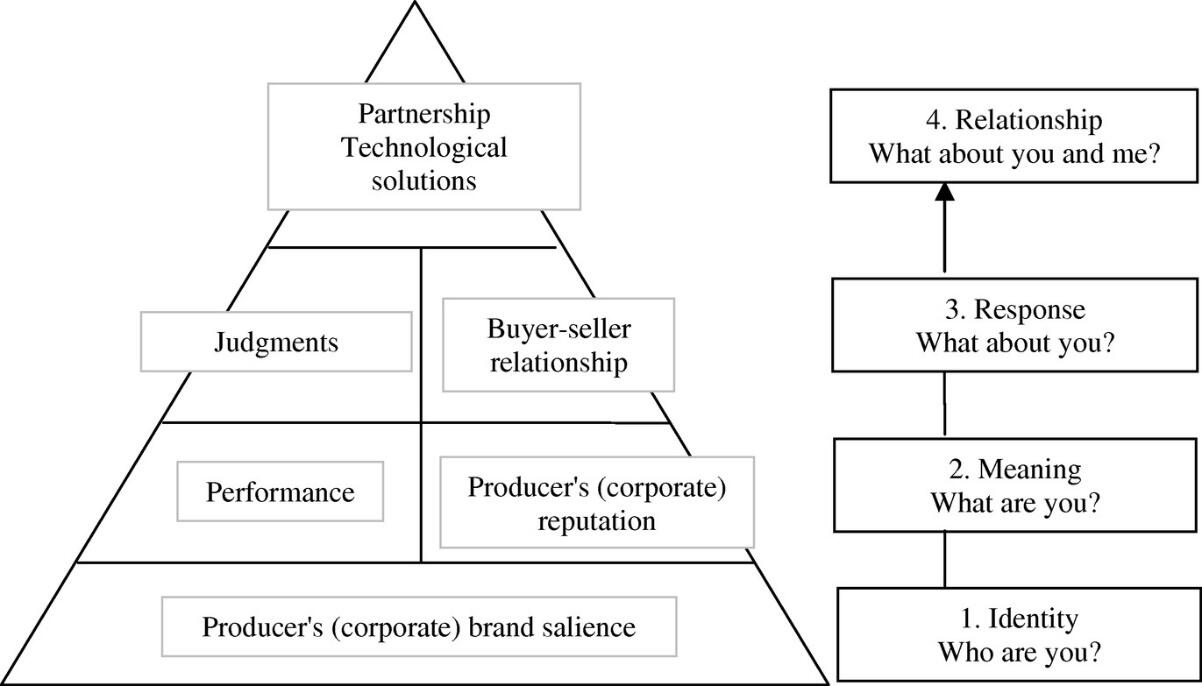
Brand Architecture
The current architecture of Bottega’s brand can be described as the branded house, in which all of the products exist under the umbrella of Bottega’s main brand. However, with the creation of a new brand that will incorporate everyday items, the need to revisit the existing approach toward branding may emerge. Since most of the products to be marketed to their target audience are quite diverse, ranging from coffee cups to umbrellas to computer cases, the company will need to consider creating a house of brands.
Brand Leveraging
At the earliest stages of promoting its new products, Bottega will rely on the power of its current brand to a significant extent. In other words, brand leveraging will need to be applied to build brand loyalty in the target population. For this reason, the new brand will have to incorporate the elements of the current one, such as the title and possibly the font.
Since the current products created by Bottega are completely divorced from the new brand, which is going to be represented not by luxurious items such as fashion bags but by everyday products, it is expected to create some difficulties to borrow the key elements of the existing brand to create the new one. However, the corporate philosophy of the company, which promotes individuality and confidence, can be used to design the new brand (Hsu, Fournier & Srinivasan 2016). Bottega will need to market its new brand as the items that provide their users with confidence due to the high quality and the impressive end result.
Brand Positioning
While the current brand by which Bottega is represented in the target business environment is rooted mostly in the concept of luxury, the new one will have to be based on the idea of utility and positioned as useful in everyday routine. The elements of luxury such as specific design choices and the materials used for the new products will be added as complementary items that will help to increase brand recognition (Wang, Ghalih & Porter 2017). Therefore, the new brand should be positioned as the extension of Bottega Veneta that will focus on quality and the attempt at incorporating comfort and even luxury into everyday life.
Branding Strategy
AIDA
To stir public interest toward the brand, the AIDA model (Awareness, Interest, Desire, Action) will be required. Specifically, Bottega will have to introduce the audience toward its new project, incite interest toward the new brand of everyday items, make sure that the public wants the product, and encourage target customers to buy it (see Fig. 6). For this purpose, a campaign will be developed along with an official website. To build desire in buyers, elements pf luxury and comfort will be emphasized in advertisements. To encourage action, a customer loyalty program will be created.
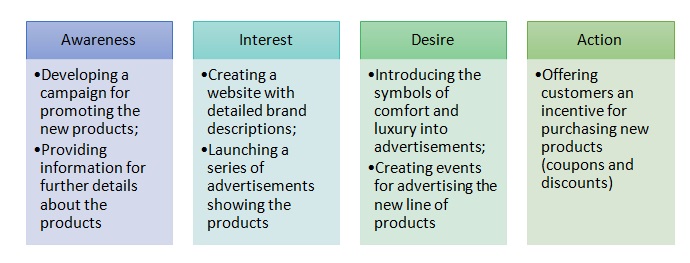
RACE
In addition, the RACE (Reach, Act, Convert, Engage) Model will have to be applied to promote the products and spur the audience’s curiosity. Specifically, a new communication channel including ICT and modern media will be built to reach out to customers. To encourage action (“Act”), interactive elements will be introduced into the website so that buyers could customize their experience. The conversion process will start as soon as Bottega builds a team of devoted fans with the help of discounts, gift certificates, and similar tools. Finally, the engagement stage will imply listening to the feedback and adjusting the products to the clients’ needs (see Fig. 7).

Licensing/IP
The rights to the intellectual property and the products will belong to Bottega since the new brand will be issued under its name. Thus, the intellectual property rights will be granted to Bottega not because of the concept behind the products, namely, the introduction of comfort and a bit of luxury into daily routine. Because of the use of the company’s current logo as a part of the logo to be designed for the products in question, it will be necessary to recognise the property rights of Bottega as the owner of the intellectual property in question.
Brand Elements
The current brand that represents Bottega in the global market comprises of several elements, which include the concept of luxury and the idea of elegant simplicity. The tagline of Bottega Veneta, which says, “When your initials are enough,” represent the company’s stance on what luxury is and how it can be expressed with the help of accessories and fashion items (‘Bottega Veneta’ 2019). The proposed brand elements include the logo, prints, icons, packaging, and colours.
Brand Identity Logo
The current brand identity logo is quite simplistic and, therefore, unique. Therefore, the logo to be designed for the company’s foray into the new market will have to retain the same flair of elegance and stylisation. For this purpose, the logo will have to retain the outline of the company’s initials written in a sans serif font. The specified approach will highlight the company’s integrity and keep its focus on its values and philosophy.
Logo Colour
With the use of color-coding for each product, customers will recognise Bottega’s products easily even among a range of others of a similar design. It will be sensible to use the colours that will allow differentiating between products immediately; therefore, the use of contrasting colours, such as red, blue, yellow, and green, as well as any other colour that will help the product to be easily labelled as belonging to a particular category, will be needed.
Icons and Prints
The brand icons will have to be considerably less detailed than the logo to make them easily distinguishable. However, simplifying the existing brand is rather difficult given the fact that it is represented by the name of the company. The deliberate use of the sans serif fond may simplify the task, yet there are still major obstacles to overcome. For this purpose, the logo will have to be simplified to the first two letters (BV) in the traditional sans serif font and the assigned colour.
Packaging
The packaging will be biodegradable, recyclable, and reusable, as well as non-toxic and hypoallergenic. Bottega will have to position itself as an environmentally friendly company, which means being considerate about the packaging used for the products. To save the resources, each of the produced goods will be available not only as a single unit, but also in batches of three, six, and twelve.
Brand Strategy
Five Objectives of the New Brand Strategy
The key objectives of the new brand strategy will include attracting new customers, expanding into a new market, diversifying production, locating new partnership options, and gaining a better reputation in the global business setting. Bottega will acquire quite a competitive advantage once it embraces everyday items as its possible products.
Digital Branding Recommendations
For Bottega to become comfortable in the digital setting, social networks should be used to promote the new items to customers. In addition, an application that will help potential buyers to navigate the company’s production line better has to be designed. Thus, Bottega will gain immediate traction in global economy.
Digital Customer
The portrait of the digital customer of Bottega is quite complex. Currently, it includes appreciation for craftsmanship, knowledgeability, loyalty to the brand, and appreciation of customisation options. In the digital setting, the focus on customisation is likely to increase. Consequently, the opportunity to enjoy the products that are intended specifically for them will have to be used to attract customers. Specifically, the company will have to consider different types of each item, such as tote bags and umbrellas with unique patterns.
Reference List
Bottega Veneta 2019, ‘Bottega Veneta,’ Vogue.com, Web.
Çifci, S, Ekinci, Y, Whyatt, G, Japutra, A, Molinillo, S & Siala, H 2016, ‘A cross validation of Consumer-Based Brand Equity models: driving customer equity in retail brands’, Journal of Business Research, vol. 69, no. 9, pp, 3740-3747.
Hsu, L, Fournier, S & Srinivasan, S 2016, ‘Brand architecture strategy and firm value: how leveraging, separating, and distancing the corporate brand affects risk and returns’, Journal of the Academy of Marketing Science, vol. 44, no. 2, pp. 261-280.
‘Marketing, strategy & management’ 2017, Van-Haaften.nl, Web.
Our history 2019, Web.
Rashid, S & Ghose, K 2015, ‘Organisational culture and the creation of brand identity: retail food branding in new markets’, Marketing Intelligence & Planning, vol. 33, no. 1, pp. 2-19.
Sinčić Ćorić, D & Jelić, D 2015, ‘Applicability of Keller’s brand equity model in the B2B chemical market’, Economic Research-Ekonomska Istraživanja, vol. 28, no. 1, pp. 1006-1017.
Sowray, B 2019, ‘The handbags you won’t regret investing in’, Elle.com, Web.
Toldos-Romero, MDLP, & Orozco-Gómez, MM 2015, ‘Brand personality and purchase intention’, European Business Review, vol. 27, no. 5, pp. 462-476.
Wang, TC, Ghalih, M & Porter, GA 2017, ‘Marketing public relations strategies to develop brand awareness of coffee products’, Science Journal of Business and Management, vol. 5, no. 3, pp. 116-121.
Appendix A: Digital Pen Portrait
